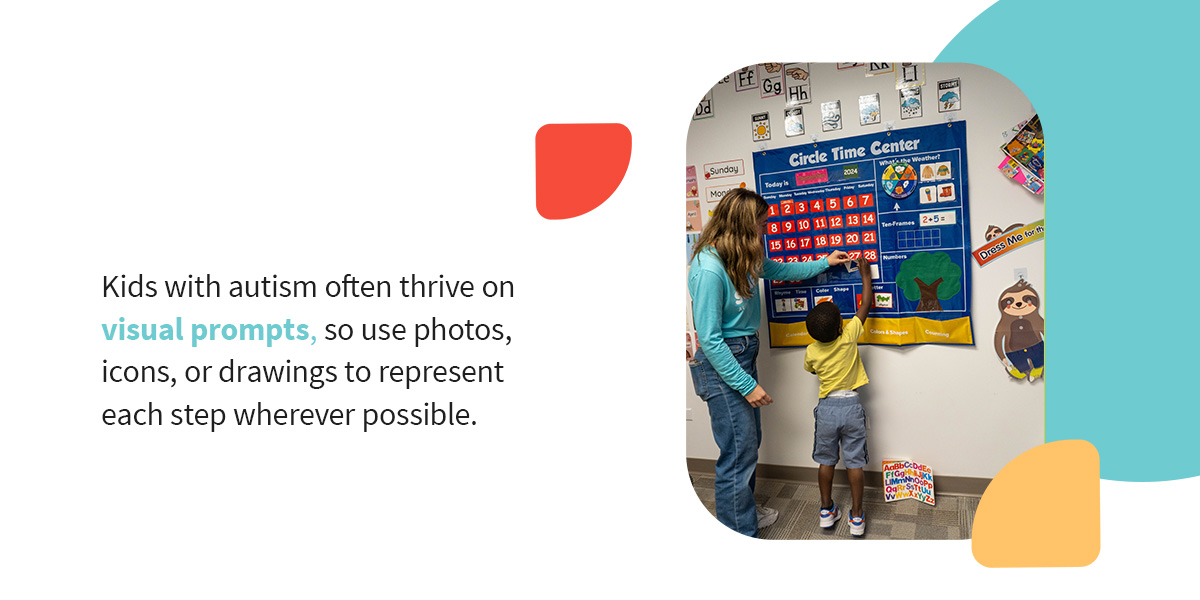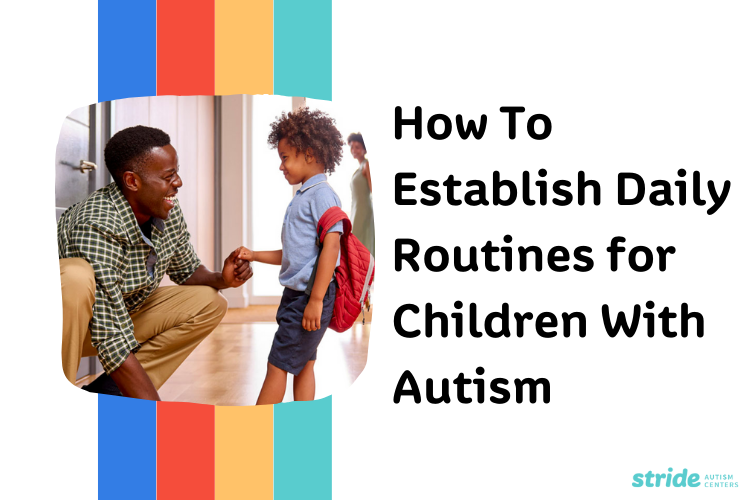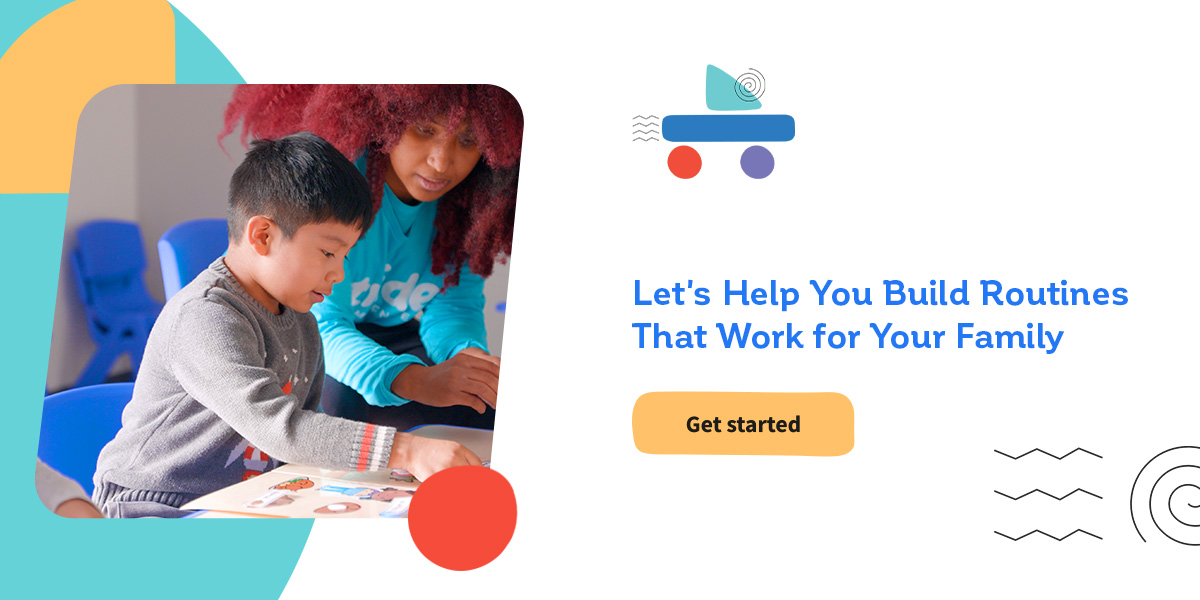Family routine helps smooth out our busy days. It’s especially important for children with autism spectrum disorder (ASD). Daily routines are really a series of gentle touchpoints that give your kiddo a sense of safe predictability as they learn new skills and thrive.
To put your mind at ease, there’s no need to round up the colored markers or fire up a spreadsheet. Building a daily routine for a child with autism can be as simple as creating patterns with daily tasks you would be doing anyway.
In this guide, you’ll find practical, evidence-based advice — rooted in Applied Behavior Analysis (ABA) therapy — to help you build routines that work for your child and your family.
Four Steps and You’re Done!
Building routines for children with autism doesn’t have to be overwhelming. Start small, focus on your child’s strengths, and use visual supports to make each step clear and achievable.
1. List Daily Activities
These are usually centered on morning activities, mealtimes, play, learning, quiet time, and bedtime. Then break it down into tasks:
- Use the bathroom
- Wash face
- Brush teeth
- Get dressed
2. Say It With Pictures
 Kids with autism often thrive on visual prompts, so use photos, icons, or drawings to represent each step wherever possible. A fun, easy way to do this is to take a photo of your child completing each task. Write each task on a peel-and-stick label and assign it to the relevant photo. Cover with self-seal laminating sheets from an office supply store, then add a Velcro strip or sticky tack to attach it to a felt board or poster board.
Kids with autism often thrive on visual prompts, so use photos, icons, or drawings to represent each step wherever possible. A fun, easy way to do this is to take a photo of your child completing each task. Write each task on a peel-and-stick label and assign it to the relevant photo. Cover with self-seal laminating sheets from an office supply store, then add a Velcro strip or sticky tack to attach it to a felt board or poster board.
Create a “to-do” and “finished” column and move the images between the two. Place the schedule in a visible spot like the fridge or their bedroom.
3. Use Timers and Cues
Visual timers or gentle alarms can help signal when it’s time to move to the next activity or count down brushing teeth for a full two minutes. “First/Then” boards can map out what happens now and what comes next.
4. Start Small and Practice Together
Introduce one routine at a time. Walk through the routine with your child — bedtime bath, brush teeth, pajamas, one bedtime story, turn off the light. Offer support and encouragement and celebrate each completed step, no matter how small.
When your child is comfortable with one routine, gradually add more steps or introduce another. Routines for children with autism should include some flexibility or transition time to help them navigate change.
Tips for Managing Transitions and Unexpected Changes
Some children are attached to the predictability of a routine and may get upset if something changes. With a little planning and the right tools, you can help your child handle changes with more confidence. Here’s how:
- Prepare in advance: Talk about upcoming changes as early as possible. This might be adding in a new step, like using the toilet before bed, or sticking to the routine while staying over at a family member’s house during the holiday season. Present the change as a positive or new adventure, be calm and upbeat, and give yourself some grace — building routines for children with autism is a journey, and you’re doing great.
- Practice transitions: Roleplay new situations at home and use countdowns or visual timers to signal when a transition is coming.
- Offer choices: When possible, let your child choose between two options. For example, you might ask, “Do you want to brush your teeth or wash your face first?”
- Coping strategies: Encourage them to use comfort items, like a favorite toy or pair of headphones, and practice calming techniques, like deep breathing or squeezing a stress ball.
- Stay flexible: Reassure your child when their routine gets disrupted, and use visual supports to show what will happen next.
Encouraging Independence and Confidence
One of the greatest gifts you can give your child is the confidence to do things on their own. By celebrating progress, you help your child build independence and self-esteem.
Fade Support Gradually
Start by guiding your child through a routine, modeling each task and offering hands-on help or verbal prompts. As your child becomes more comfortable, step back and let them try the steps on their own. Over time, you can move from giving physical help to gentle reminders, and eventually to simply offering encouragement.
Celebrate Small Wins
Praise your child for every step they complete independently. Offer specific, enthusiastic praise for each achievement, no matter how small — for example, “Great job putting on your shoes by yourself!”
Positive reinforcement, like stickers, tokens, or extra playtime, can be very motivating. Share your child’s successes with other family members to foster a feeling of pride. Remember, every bit of progress counts, so be sure to acknowledge your child’s effort as much as the results.
Involve Your Child
Let your child pick out pictures or drawings for their schedule, making it more personal and engaging. While creating a daily routine for a child with autism, allow them to decide the sequence of certain activities whenever possible. This can give them a sense of control. Encourage them to check off or move completed tasks on their board so they build ownership and responsibility. Asking for their input on what helps them feel ready for each part of the day can also make routines more successful.
Yay to Problem Solving
If your kiddo gets stuck, ask guiding questions and resist giving the answer right away. Use prompts like, “What comes next on your schedule?” or “What do we do after breakfast?” to encourage them to think through solutions, even if it takes a little extra time. If they need support, offer hints or choices, but let them make the final decision. Celebrate their effort to figure things out — this helps reinforce valuable problem-solving skills.
Model Independence
Show your child how you follow routines and handle changes calmly. Demonstrate your own routines and talk through your actions, like saying, “Now I’m brushing my teeth, just like you!” When plans change, talk through your feelings and coping strategies aloud — for example, “I wasn’t expecting this, but I’ll take a deep breath and adjust.”
Let your child see you using visual schedules, timers, or checklists, so these supports feel normal and helpful. By being patient and positive, you’re setting a reassuring example for your child to follow. Remember, you’re making a meaningful difference in their life every day. Be kind to yourself, and know that it’s OK to learn and grow alongside your child as you build these routines together.
Partnering With Your ABA Therapy Team
As a parent, daily routines for children with autism offer natural opportunities to strengthen their communication and social skills. Your ABA therapy team is here to support you and your child every step of the way. We help you recognize these teachable moments within your family’s routines and show you how to make the most of them, turning everyday activities into meaningful learning experiences.
Here’s how we can support you:
- Collaborate on goals: Share your child’s strengths and goals with your therapy team as we work together to reach realistic, meaningful milestones.
- Consistency across settings: We love hearing about your daily routine successes so we can use similar visual supports and language in the center.
- Ongoing support: At Stride Autism Centers, our team offers caring learning environments and hands-on guidance for families at each location.
Let’s Help You Build Routines That Work for Your Family
If you need help or advice on how to create a routine for a child with autism, Stride Autism Centers is here for you. Our center-based, play-based ABA therapy programs are for kids with autism ages 2 through 6 and are designed to meet your child’s individuality and your family’s unique needs. Our team works closely with you to establish practical routines with hands-on guidance and ongoing reinforcement every step of the way.
Call our caring, experienced team at 515-207-5251 or connect with us online to see how we can help your child thrive with routines that truly make a difference.







